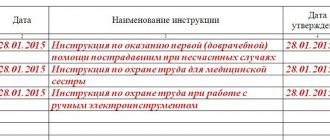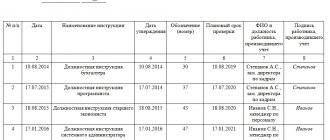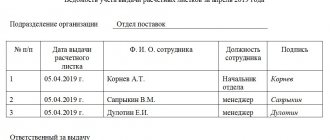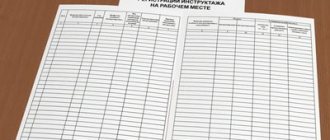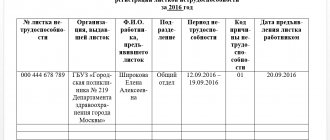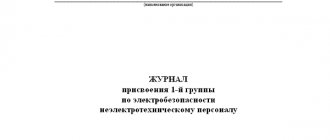Each enterprise in the course of its activities receives and sends a certain amount of correspondence.
A clearly organized document flow system will ensure the order and safety of business correspondence, help in resolving controversial issues, eliminate groundless claims and provide the necessary evidence during the trial process.
An important element of effective office work is recording incoming/outgoing papers by registering them in a journal.
Thus, a log book is a register containing information about documentation that an enterprise receives and sends by any delivery method. Outgoing and incoming mail are logged separately , so two separate logs must be maintained.
Types of journal: their advantages and disadvantages
Considering the volume of processed correspondence, management personally determines the type of journal acceptable for the enterprise : paper version, similar electronic manual version, or registration using an EDMS.
As a paper journal, they use a book made in a printing house (A4 format) with pages in the form of a table and the ability to enter the necessary columns.
Sometimes they use ordinary notebooks and manually draw the columns of the required columns.
Fill out a paper journal with a pen (acceptable ink colors are blue, blue and violet). The advantage of a paper journal is the reliability of data safety; its use is justified when registering papers that, due to their special importance, have a long shelf life. The disadvantage of this form of accounting is the inconvenient and lengthy search for the required document.
An electronic journal is a table in an xls, doc, docx file similar to the paper version. The finished template can be downloaded from the Internet or created independently in a standard office program Excel or Word.
Among the advantages of this type are quick search and the ability to sort documents. You can place hyperlinks to an Internet resource or scanned copies of documents in the table.
Access to receiving and editing information in the electronic journal can be granted to all employees, or it can be limited to a certain circle of people.
This form of registration does not require large investments; basic knowledge of a PC user , but the lack of data backup entails the risk of distortion or loss of information in the event of a system failure.
As a compromise, you can keep two journals at the same time , using the electronic one as the main one, and the paper one as its backup copy.
An innovative method of registering correspondence - an electronic document management system (EDMS) is used preferably by large companies dealing with a large volume of papers.
There is a wide range of demo versions , which differ from licensed programs only in the established restrictions on the period of use or the number of users (up to 5-6 people, for example, Fossdoc).
The disadvantage of this type of accounting is the danger of access to information by strangers when hackers hack into employee pages. When deciding on the feasibility of implementing an EDMS, they analyze the needs of a particular enterprise and the volume of its document flow.
Who fills it out
The head of the organization and heads of company departments, if any, are directly responsible for the timely completion and maintenance of the journal. However, in practice, these employees already have many responsibilities that cannot be delayed.
So, almost any employee (with the appropriate education) can fill out the log and be responsible for fire safety in the organization. In this case, it is important for the manager to sign an order or instruction appointing such a person from among the employees of his organization, or he will have to fill out everything himself.
Documents not subject to mandatory registration
Let's consider the rules for receiving and registering incoming documentation. Not all mail received by an enterprise relates to its direct activities. Sometimes letters of a general nature and various types of advertising (periodicals, brochures, etc.) arrive.
Therefore, you first need to select everything that does not relate to the main activity , and then, guided by the list of unregistered correspondence (approved as an appendix to the instructions regulating the rules of office work in a given organization or a separate order), determine which of the remaining documents are subject to registration and which are not.
According to the general rules, you may not register :
- Congratulatory and personal correspondence .
- Press and periodicals.
- Anonymous correspondence of unconfirmed origin (documents without a signature or seal, which do not have other details identifying the sender).
- Business offers and mail sent as advertising .
- Invitations to attend or take part in promotional events
- Forms and forms , except for strict reporting.
- Accounting papers and documents for resolving administrative and business issues, if there is no cover letter .
What to do if the book of movement of work records was not kept?
The absence of a record book or its improper execution is a gross violation of labor legislation.
At the first inspection by labor inspectors and such a serious defect in work is discovered, penalties will be imposed. If the head of the enterprise, who is responsible for organizing personnel records management, has discovered this problem, he needs to urgently take measures to correct it.
Typically, the absence of a journal is observed among individual entrepreneurs , who until recently were not allowed to maintain a labor code.
Accordingly, in such conditions, their accounting books were not created. Currently, you need to create a journal, including all available employees working for a legal entity.
To do this, you need to prepare a journal according to all the rules, fill out the title page, and then enter in chronological order all available employees. That is, under number 1 should be entered the one who got a job earlier than everyone else, and then - the books of those who got a job later (one by one). It’s okay that the date the log was filled out and the date the employee was hired are different. The main thing is that the document is prepared properly.
Download the book form for recording work records and inserts for them.
Sample of the title page of the work record book and inserts for them
Decor
Having decided to use a paper version of the magazine, before starting work, the new book or notebook must be numbered, eliminating the possibility of tearing out pages. to flash the magazine as it is not a strict reporting document.
On the title page you must write the name of the enterprise, the date and its nomenclature number. On the 2nd and 3rd pages you need to indicate the person responsible for registration (full name), position held, details of the document assigning this responsibility to the employee, period of work and signature. From the 4th page you can start the actual registration.
Completed logs are stored for 5 years.
A sample of filling out the outgoing correspondence log.
Sample of filling out the log of incoming correspondence.
Registration with the SSN authorities
The general work log, like other special work logs, if state construction supervision is carried out during the construction of an object, must be registered with these authorities.
According to Part 5 of Art. 52 of the Civil Code of the Russian Federation, the general log of work when submitting a notice of the start of construction must be transferred for registration to the State Construction Supervision Authority.
Before this, it must have title pages, the magazine must be bound and numbered, and secured with the seal of the developer’s organization. If the developer is an individual, then only a signature is sufficient.
Basic graphs
generally accepted standards of office work, the registration journal must have six main columns that display the minimum amount of information required for full accounting.
The first mandatory column “registration number” assigns a unique code , consisting of a serial number and the nomenclature number of the registration journal, which allows you to identify it and determine its location.
With a three-digit number structure, the third digit may indicate the department to which the document is addressed or the code of the case intended for its storage. Numbers are written separated by a dash or slash (for example, 42-15/03, 42-15/04, 42-15/05 or 01/18, 02/18, 03/18, etc.).
The second column “document date” is mandatory because it records the date (day, month, year) when the document was received by the enterprise.
The data of the first two columns, using a stamp or manually, is affixed to the document, for example: In. No. 42-15/01 dated July 25, 2015.
The third column “type of document” contains data that determines its content and purpose , for example, a request, an internal memo (internal type of document), etc.
The fourth column “correspondent” identifies the author of the document. When writing down the company name, you are allowed to use only well-known abbreviations.
The fifth column “content” displays the title indicated at the beginning of the text; if it is missing, you should briefly describe the essence of the document .
The sixth column “performer” is filled in after the manager has reviewed the document and indicates which employee he has entrusted with its implementation.
Reasons for maintaining a document
The log is needed to record the availability of the necessary equipment and monitor its maintenance. But the primary means of extinguishing fires include not only fire extinguishers. It's the same:
- fire shields on which hooks, shovels, axes and other tools are located;
- water tanks;
- sand boxes;
- special cloths for extinguishing - koshma.
Responsibility for compliance with fire safety lies with the head of the organization.
The rules for compliance with fire safety are established by Decree of the Government of the Russian Federation No. 390 “On the fire safety regime” (together with the “Rules of the fire safety regime in the Russian Federation”). Paragraph 478 of Section XIX of these rules states that the primary means for extinguishing a fire and the time of their inspection are taken into account in a special journal. The form of reference is arbitrary.
You are allowed to develop the magazine yourself. A sample of how to fill out the primary fire extinguishing equipment logbook will show you how to do this. In practice, fire extinguishing agents are often monitored on two different forms. This is a separate document for fire extinguishers and a separate document for the rest of the equipment. Some experts advise, for convenience, to separate the accounting of the fire extinguishers themselves (listing their main parameters) and their maintenance and inspection. But when checking, it will be enough to have an operational passport and one logbook, which, among other things, reflects the maintenance and inspection of equipment. If the rest of the fire equipment (fire shields, sand, etc.) is not indicated in the document, along with fire extinguishers, a separate form is required for it.
Additional columns
Unlike the mandatory ones, additional columns are used at the discretion of management.
In the “resolution” column - the entire instruction given by the manager to a specific performer . For example, “Smirnov A.A. For information", "Smirnov A.A. Prepare a draft agreement."
In the “completion mark” column, it is recommended not to simply indicate “Completed”, but to provide a list of measures taken or the reason for non-compliance. Analysis of the last two columns will provide an opportunity to assess the compliance of the work done with the task.
Using the column “date of resolution” will help avoid misunderstandings if the manager reads the document after the date of its registration, which led to a delay in solving the task. For example, in the column “date of resolution” it is indicated 07/22/2015, and in the column “date of resolution” 07/26/2015, therefore, the issue was not resolved on time due to the fault of the manager himself.
In the column “outgoing number, date of document” information about the correspondent is recorded, which speeds up the search for the required letter, and may also be needed in case of loss of the original , to draw up a request for a duplicate. If there is no outgoing number, indicate “b/n” (without number).
You can supplement the journal with columns displaying information about the delivery method, or the number of pages and the presence of attachments, if the company’s correspondence requires strict accounting.
Fire extinguisher log form
Keeping a record book is mandatory at every enterprise that has fire extinguishers on its balance sheet. There are two management options:
- in accordance with the model contained in the regulatory framework;
- arbitrary, repeating the graphic part of the material accounting book.
✎ Free form
There is a list of items that should be contained in the journal. This number includes:
- name of the fire extinguishing device;
- serial number and production date;
- where the device is used;
- when recharging took place;
- signature of the official;
- notes.
✎ Recommended form
In the Code of Rules 9.13130 of 2009, you can find formalized recommendations for maintaining an OT log. They contain the following information:
- information about the date of commissioning;
- number assigned to the product;
- model name;
- where the device is located;
- device serial number;
- when the OT was released;
- degree of concentration of OTS;
- data on inspection and condition of the device;
- information about the results of maintenance;
- product weight;
- operating pressure;
- information about the chassis of mobile devices;
- data on actions taken to repair and restore the material part of the device;
- signature and details of the official.
Filling rules
It is customary to observe the following generally accepted “unofficial” rules :
- The document must be registered promptly on the day of receipt; in some cases, the registration period may be extended by order to 3 days.
- Adhere to the one-time principle, i.e. The document is registered 1 time . In cases where a scanned copy is received by e-mail and delivered later by regular mail, the original is assigned the number of the already registered copy of the letter.
- should as completely as possible . For example, when setting out the essence of a document in the “Contents” column, make sure that its meaning is not lost.
- At the beginning of the year, you need to reset the numbering without having to start a new journal.
You can find out about the specifics of maintaining, who should fill out and what is the procedure for registering logs for registering official notes, on labor safety briefings, recording the issuance of work books and checking military records in our articles. Additionally, we will tell you about the log of working hours, fire extinguishers, inspection and testing of power tools, registration of fire safety instructions, the book of the cashier-operator and the sanitary log.
What is OJR
The general work log, or OJR for short, is the main work log in which an authorized representative of the person carrying out the construction makes daily entries about the completion of work. Also, representatives of construction control and supervision make entries into it with comments identified during construction. OZHR is the face of all construction; it is one of the main documents that is looked at most often.
Regulatory document
The main normative document that establishes the procedure for maintaining the OJR and the form of the form is RD 11-05-2007. This document presents the established journal form and describes the entire procedure for maintaining it.
In Part 6 of Art. 52 of the Town Planning Code of the Russian Federation establishes that the form and procedure for maintaining general and special work logs can be established by regulatory legal acts of the Russian Federation. RD 11-05-2007 is just such a document.
Also, in the codes of practice, reference is constantly made to the need to make entries in the general work log.
Why create a scientific journal?
The scientific community functions and its members interact with each other through publications. Scientists learn information about new technologies, ongoing research, and achievements in various fields of knowledge from scientific journals. No researcher can be a professional in his field if he does not get acquainted with the latest publications on the topics of his and related disciplines. On the other hand, each published work serves as confirmation that a scientist has conducted new research or made a discovery.
It is believed that the state of world science can be assessed by the quality of articles published in journals. With the advent of scientific journals, the global community has managed to unite different groups of specialists and connect them with similar interests and goals. This innovation led to a dramatic increase in communication between researchers and contributed to the growth of knowledge through simplified information exchange.
Many authoritative publications emerged in the 20th century. Previously, these were valuable sources of knowledge from various fields of science, which today have lost their former value and significance. It's all about the aging and loss of relevance of the scientific communities that created them. The need for new progressive and specialized sources of information leads to the need to create new scientific journals that would satisfy the needs of modern communities.
There is another good reason to publish a scientific journal - to eradicate the habit of unscrupulous publications to profit from scientists, demanding from them a certain (often considerable) fee for publishing material. Researchers have no choice, especially applicants, since publishing articles is one of the requirements for defending a dissertation. And magazines, in turn, take advantage of this and demand a reward for each article. Even though, according to the requirements of the Higher Attestation Commission, graduate students must publish for free.
In order not to impede the development of science in our country, it is necessary to create new scientific journals that would function in the interests of scientists, and not strive for profit. Publishers could make money from advertising and selling links, allowing authors to publish for free and making their work publicly available.
What local acts are recorded in the journal
Orders that establish certain local standards for all or most employees of an enterprise, both management and ordinary, are subject to registration. Such administrative acts may reflect:
- business issues;
- planning system;
- reporting procedure and structure;
- building a sales strategy;
- business expansion tasks.
Typical orders, entries about which are made in the book, can be orders on:
- appointment of a director;
- creating a branch;
- introduction of staffing;
- approval of labor regulations;
- ensuring trade secrets;
- conducting internal audits and certifications, etc.
Types of fire extinguishers
The design of the fire extinguisher is also of paramount importance. There are:
- Air foam devices. They are filled with foam.
- Aquatic. Their filler is carbon dioxide.
- Gas fire extinguishers. They are filled at the factory with refrigerant.
- Powder.
- Mixed type.
Moreover, there are portable models, whose maximum weight is 20 kg, and there are mobile ones, with a powerful chassis. Their weight can reach 4 centners. According to regulations, the maximum distance that can separate a fire extinguisher and a probable source of fire is 20 meters. Accordingly, between two places where fire safety equipment is located is 40 meters. A diagram of placement standards with the type of equipment taken into account is placed in the first appendix to PPR No. 390.
Reload
To ensure that the internal contents of the equipment are always in order and that the fire extinguisher logbook always contains correct information, fire extinguishers must be periodically recharged. There is even a separate document about this - a log of testing and recharging fire extinguishers.
The duration of this recharge will depend on the type of substance filling the device. For water fire extinguishers, the recharge rate is once every 1 year, as for foam ones. Even if water with specialized additives is used, this rule always applies.
Recharging firefighting equipment every year is quite a hassle. If the manager (or the person responsible for fire safety) is not satisfied with this situation, then it is necessary to purchase carbon dioxide, powder fire extinguishers or equipment with freon for the safety of your premises.
In these three cases, fire extinguishers will have to be recharged no more than once every 5 years. However, you should monitor their condition and make notes on checks in the fire extinguisher log book with the same frequency - once a year.
Logbook for registering orders for personnel: document structure
As noted above, the legislation does not establish a single form of the document, therefore each enterprise develops its own convenient form, applicable in current production conditions . Columns are entered into the Journal that allow you to quickly find the required document and make it possible to control their circulation.
As practice shows, most often the Book consists of the following parts:
- title;
- list of persons responsible for maintaining the Book;
- the main section containing columns where information about the administrative document is entered.
Title
The title page of the document contains the following information:
- full name of the company (without abbreviations or abbreviations);
- the name of the Book “Journal of registration of orders”;
- date of creation of the report notebook;
- end date of maintenance (will be entered when the sheets in the Journal run out).
List of responsible employees
The appointment of a responsible person occurs through the preparation by the head of the relevant Order. If the employee agrees with the powers entrusted to him, then he signs the administrative document. And only after this information about the employee will be added to the Journal.
So, on the second page of the document the following data should be displayed:
- last name, first name, patronymic, position of the responsible employee (there may be several);
- details of the Order of the employer who appointed the responsible person;
- signature of the responsible employee confirming the beginning of the execution of entrusted powers.
Main section
All pages of the book are numbered and stitched. This is done to preserve information about the administrative documents drawn up. There are no uniform requirements for what data should be entered in this section. But, as practice shows, the most necessary graphs will be the following:
- serial number of the signed document;
- date of signing and registration of the Order;
- type of administrative document (on leave, on hiring, on dismissal, on imposing a penalty/incentive);
- a list of employees affected by the Order;
- a normative act on the basis of which an administrative document has been prepared (call from the place of study, vacation schedule).
What is a room disinfection log?
To avoid problems during an audit, you need to not just put another log on the shelf with documents, but regularly fill it out in accordance with legal requirements. The absence of a document gives Rospotrebnadzor the right to issue an order, a fine, suspend activities or apply other sanctions against the enterprise.
Frequency of disinfection
Regular disinfection is the responsibility of all organizations that are allowed to operate during a pandemic. The frequency of treatment depends on the functional purpose of the object and room, the type of surface, and the number of people in the building. For example, in stores, shopping carts and baskets, cash registers, door handles and other contact items should be wiped down every two hours. At the beginning and at the end of the working day, wet cleaning should be organized using virucidal disinfectants.
What is a room disinfection log? What is it for? The document must tell at what time and by whom the processing of the office, sales area, hall, and dining room was carried out. New information is added immediately after disinfection is completed. In the event of an unscheduled inspection, Rospotrebnadzor employees will be able to ensure that the enterprise complies with the required premises treatment schedule.
